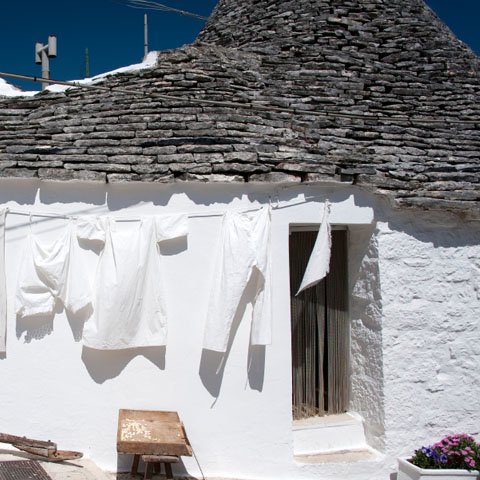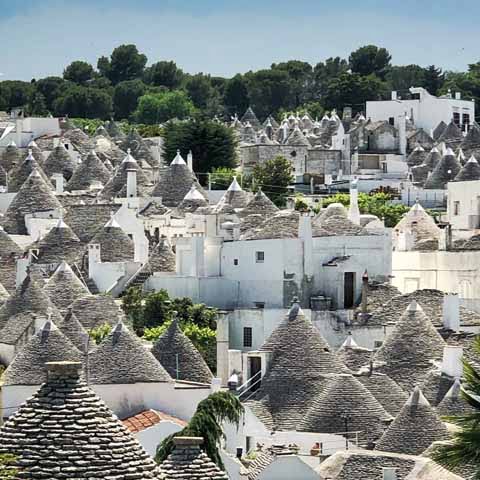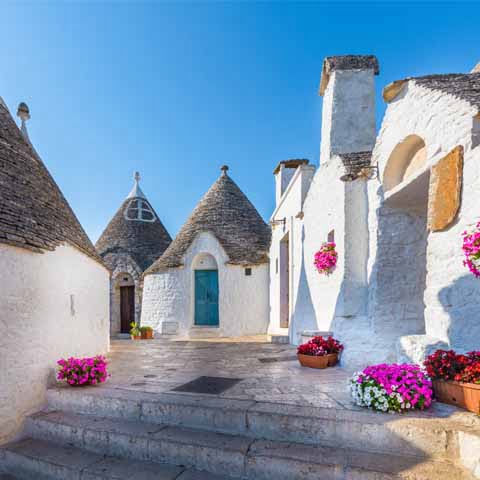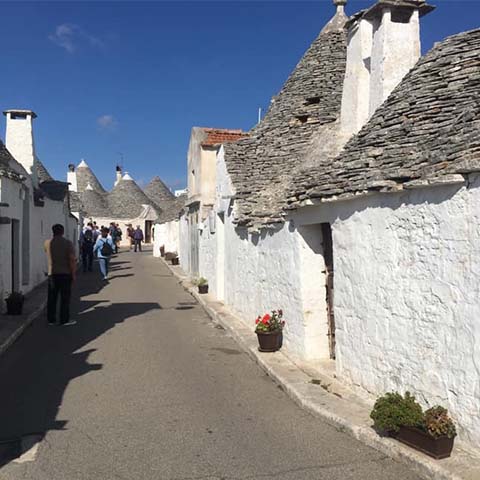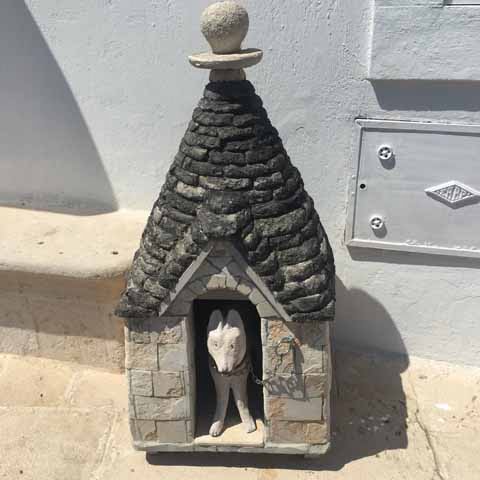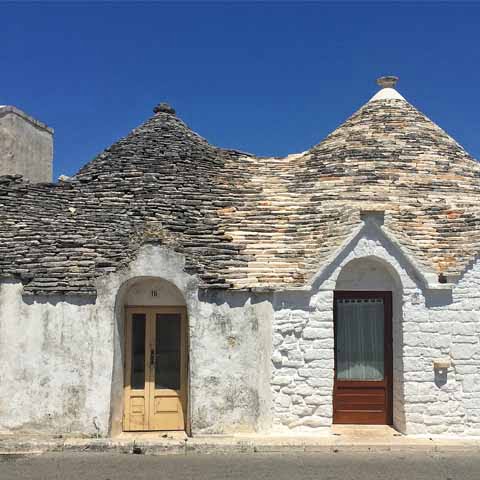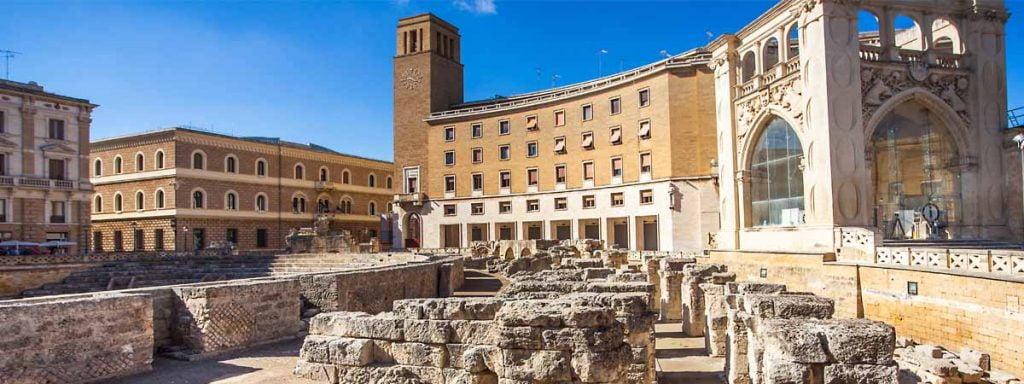The small town of Alberobello is a relatively young city compared to others throughout Italy and has only recently been discovered by international travelers. Yet it maintains all the unique, historic, and cultural characteristics that those visiting Italy so often crave.
The city is marked by its iconic trulli dwellings – cone-shaped, white, dry stone structures that truly transport travelers back in time – and the local lifestyle is based on the city’s peasant history. Locals embrace a simpler, more rural way of life, which honors the city’s rich past.
The town is a recognized UNESCO World Heritage Site because of the famous trulli buildings, ensuring the preservation of the area’s most captivating historic and cultural qualities.
Its location in Apulia adds to the city’s cultural offerings, as the region itself is known for having a rich history and unique archeological heritage. Many populations from various places across the Mediterranean traveled through Apulia to get to Italy, leaving their cultural mark throughout the area.
ART IN ALBEROBELLO
The town of Alberobello is steadily growing in popularity thanks to its trulli structures. In 1996, after the town was recognized by UNESCO as a World Heritage Site, a desire to preserve the area’s history and tell the story of the trulli grew, ultimately creating the Casa Pezzolla Territory Museum – Alberobello’s most comprehensive museum.
The Casa Pezzolla Territory Museum is a trulli complex of more than 15 buildings. Housed within it is a museum that contains exhibitions of artifacts, tools, and other evidence of the area’s local history. It also contains important photographs and serves as a location to host art exhibitions. The works displayed here can range from fine art to figurative art.
Outside of the Casa Pezzolla Territory Museum, art can be admired in Alberobello’s churches, such as the Church of Sant’Antonio, which hosts sculptures by Apulia native Adolfo Rollo, and the Basilica of Santi Cosma e Damiani, where travelers can admire sculptures depicting Saints Cosma and Damiano, the patron saints of Alberobello.
ARCHITECTURE
By far, the most impactful and unique architectural feature of Alberobello are its many trulli buildings. The origins of these conical, limestone dwellings are rooted in prehistoric times, though the oldest surviving trulli are from the end of the seventeenth century. Exclusive to Apulia’s Itria Valley, the largest and oldest collection of trulli are located in Alberobello, making it the most important grouping of trulli in the world and earning the city the title of a UNESCO World Heritage Site.
The trulli of Alberobello date back to the fourteenth century and are round, cone-shaped structures that feature pointed, conical roofs made of limestone slabs. They are no longer constructed in modern times, so the trulli that are left are considered historic monuments.
What makes the trulli so unique is the one-of-a-kind construction technique. Trulli are made of limestone and are built using a drywall construction without any mortar. This technique was utilized by settlers to allow them to take down their dwellings quickly if needed. At the time, taxes were being imposed on new settlements, and because there was no mortar used in these dwellings, settlers could avoid them by living in “impermanent” homes. In addition, the region had an abundance of limestone available, making these structures ideal for the area.
Visitors to Alberobello can walk through the city’s trulli districts, enjoying the sight of these historical structures. Many restaurants, bars, and shops operate out of the trulli and travelers can even opt to stay in a trullo as opposed to staying in a traditional hotel.
Certain areas of the city, such as the Belvedere Trulli lookout point, offer panoramic views of the trulli. Described as storybook-like by many, the trulli are an absolutely unique sight to see.
Another beautiful display of architecture to see in Alberobello is the Church of Sant’Antonio. Built in 1926, it features trulli-like characteristics, helping it blend perfectly into the Monti district of trulli which surrounds it. Alberobello’s main church is the Basilica of Santi Cosma e Damiano, which diverges from the typical characteristics of the trulli. This Neoclassical church dates back to the end of the nineteenth century and is in the shape of a Latin cross with two bell towers.
Among the many trulli located in Alberobello, one of the most famous is the Trullo Sovrano. It is believed to be the largest trullo ever built and today it houses a heritage museum showcasing cultural artifacts.
Another noteworthy trullo is the Trullo of Paparale, which is located in the Paparale district. The elliptical-shaped trullo is distinct from others in the area, and while other trulli had a documented purpose, it is not clear why the Trullo of Paparale was built. One possible theory is that the trullo may have served as an oratory. Today, this trullo is privately owned, and though the interior cannot be visited, the exterior is certainly worth a stop.
Found in Piazza Popolo, Curri House was the birthplace of nineteenth-century architect Antonio Curri. During his lifetime, Curri was one of the leading architects in the area and completed several projects in Alberobello, such as the Church of Santi Cosma e Damiano and Alberobello’s Monumental Cemetery. Curri was also active in Naples where he contributed to the interior architecture of Caffè Gambrinus as well as decorations in Galleria Umberto I. Additionally, Alberobello’s Town Hall was completed in 1863 under the direction of Orazio Curri and Tommaso Curri, Antonio Curri’s father. It was later expanded with the help of young Antonio Curri.
LITERATURE
Alberobello was the birthplace of twentieth and twenty-first century poet Sole Di Giuseppe. One of the leading poets in the area during his lifetime, Di Giuseppe’s poetry was influenced by nineteenth and twentieth century Italian literature as well as theology. He published several poetry collections including Murgiarsa – I canti dell’alba (1983) and Sintonia – I canti del giorno (1986).
MUSIC
Throughout the summer, Alberobello hosts a variety of festivals, including some focused specifically on music. One of the best is the Festival del Sovrano, a ten-day long festival that features concerts of all genres of music including classical, pop music, jazz, and more.
In addition to the festival, the Trullo Sovrano also hosts concerts throughout the summer, including small orchestral performances and jazz bands.
CINEMA
Due to the unique aspects of the trulli, Alberbobello was chosen as a setting for several Italian films over the years. Films shot in Alberobello include Idillio Infranto (1931), Donne senza nome (1950), Casanova ’70 (1965), Le bande (2005), Il sottile fascino del peccato (2010), and Che bella giornata (2010).
SCIENCE IN ALBEROBELLO
Alberobello is home to a branch of the Ecomuseo della Valle d’Itria (Itria Valley Ecomuseum). The museum aims to promote the local history and culture of the area with an emphasis on the relationship between the environment and urbanization. The museum also provides insight on local traditions, architecture, and artisan crafts.
Despite its size, Alberobello is one of Apulia’s key cultural destinations thanks to its large concentration of trulli structures. These unique buildings, which have captivated countless international travelers over the last few decades, provide an interesting look at Alberobello’s past and the culture of the Apulia region as a whole.
Don't just see Italy, live it.
Your dream trip to Italy has never been closer
No more endlessly scrolling travel sites. Our travel experts will craft the perfect, one-of-a-kind trip just for you.

300+
DESTINATIONS
We offer more Italian destinations than any travel site. Do and see more with Trips 2 Italy.
1 (of a kind)
ITINERARIES
Because your dream trip to Italy should be designed for you, not for the masses.
100%
PEACE OF MIND
From flights and accommodations, to food and activities - we take care of every detail.
